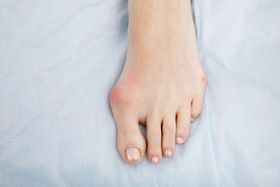Achilles Tendonitis: Symptoms, Causes, Treatments, and More
Updated December 18, 2024.

The Achilles tendon is the band of tissue that connects the calf muscles in the lower limb to your heel bone. When this tissue becomes inflamed, the result is Achilles tendonitis, an overuse injury associated with pain above the heel that is common with athletes.
This article looks at the symptoms and causes of Achilles tendonitis, different treatment options, and what you can do to reduce the risk of developing it.
Symptoms of Achilles Tendonitis
Achilles tendonitis usually causes pain at the back of the leg but can also present with pain above the heel during activities like running. It becomes more severe with high-impact activities like exercising, climbing, and sprinting. This pain is usually worse in the morning and after rest from activity.
Other symptoms include:
- Difficulty walking
- Ankle stiffness
- Tightness in the tendon
- Swelling
- Heat around the tendon
Causes of Achilles Tendonitis
While the primary cause of Achilles tendonitis is overuse, several risk factors can predispose you to the injury. Some of the most are:
- Gender Achilles tendonitis is more common in men than women.
- Age Degenerative changes occur to the Achilles tendon with age, making older people more likely to develop Achilles tendonitis.
- Anatomical problem A flat arch and tight calf muscles can predispose you to Achilles tendonitis, as well as obesity.
- Footwear Running with worn-out shoes or shoes that provide little support can increase the chances of developing Achilles tendonitis.
- Exercise surface Uneven surfaces can cause inflammation and lead to pain, tenderness, and swelling of the Achilles tendon.
- Medical conditions Conditions like psoriasis or high blood pressure put you at a greater risk of developing Achilles tendonitis.
- Medications Quinolones and Fluoroquinolones (antibiotic medications) have been associated with incidences of Achilles tendon ruptures in the past.
Treatment of Achilles Tendonitis
Treatment must be administered to the ankle as soon as possible once Achilles tendonitis is observed. The treatment aims to reduce the tension on the tendon, which is usually done in the following ways:
The RICE Method (Rest, Ice, Compression, Elevation)
An initial period of rest is necessary for healing to take place. Where this is not possible, limit activity so that only the minimum load possible is transmitted through the leg. Applying ice will help deal with inflammation in the acute phase. With compression stockings, you can increase blood flow to the area and speed up tendon healing. Lastly, elevation also encourages decreased inflammation.
Pain Medication
Non-steroidal anti-inflammatory drugs (NSAIDs) like ibuprofen can be used to decrease pain and inflammation. Unlike posterior tibial tendonitis (PTTD), corticosteroid injections are not recommended for Achilles tendonitis as they can cause the tendon to rupture.
Exercises
Strengthening and stretching exercises for the Achilles tendon are useful exercises to treat Achilles tendonitis. The stronger the muscles are, the less work the tendon will have to do. The less the load it bears, the lesser the pain that may result.
Some basic stretches are the Achilles tendon stretch, calf stretch, and plantar fascia stretch. The strengthening exercises will mostly be eccentric exercises of the Achilles tendon, gastrocnemius, and soleus muscles, thereby reducing any further risk of calf strain or worsening tendonitis.
Orthotics
Orthotics can help redistribute the pressure in the foot and consequently the amount of tension in the Achilles tendon. Likewise, heel lifts can be used temporarily to take some load off the Achilles tendon. Where it is used for a prolonged period, it can cause a shortening of the tendon.
Surgery
Surgery is considered a last resort when the non-invasive methods have been tried without commensurate results. However, where it is a total rupture, surgical repair is necessary within a few days of the injury.
How to Reduce the Risk of Achilles Tendonitis
While total prevention may be impossible, you can limit the risk of Achilles tendonitis by:
- Using appropriate footwear Footwear that is properly fitted, cushioned, and provides adequate support.
- Warm up properly before exercise Do not increase the duration or intensity of your exercise without a proper warm-up. Once done, avoid stopping the exercise abruptly too.
- Maintain a healthy body weight Excess weight increases the load on the Achilles tendon.
- Be aware of acute symptoms If you notice any sudden pain around your heel, rest from exercise, and seek the expert opinion of a podiatrist as soon as possible.
Achilles Tendonitis Management
It takes time to recover from any injury to the Achilles tendon. The actual length of recovery is dependent on the severity of the injury and the promptness/compliance with treatment. Where intervention is prompt and strictly adhered to, return to pre-tendonitis state is possible within 12-16 weeks.








